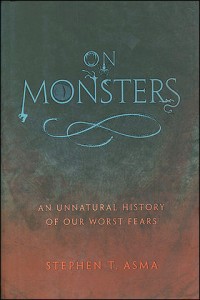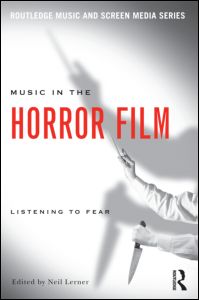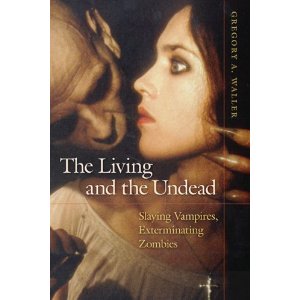 In the near future I will be interacting with the authors or editors of several books. To begin this process, I have mentioned this book in the past but am slow to finally read the volume. I have just begun Stephen Asma’s On Monsters: An Unnatural History of our Worst Fears (Oxford University Press, 2009):
In the near future I will be interacting with the authors or editors of several books. To begin this process, I have mentioned this book in the past but am slow to finally read the volume. I have just begun Stephen Asma’s On Monsters: An Unnatural History of our Worst Fears (Oxford University Press, 2009):
Monsters. Real or imagined, literal or metaphorical, they have exerted a dread fascination on the human mind for many centuries. They attract and repel us, intrigue and terrify us, and in the process reveal something deeply important about the darker recesses of our collective psyche.
Stephen Asma’s On Monsters is a wide-ranging cultural and conceptual history of monsters–how they have evolved over time, what functions they have served for us, and what shapes they are likely to take in the future. Asma begins with a letter from Alexander the Great in 326 B.C. detailing an encounter in India with an “enormous beast–larger than an elephant three ominous horns on its forehead.” From there the monsters come fast and furious–Behemoth and Leviathan, Gog and Magog, the leopard-bear-lion beast of Revelation, Satan and his demons, Grendel and Frankenstein, circus freaks and headless children, right up to the serial killers and terrorists of today and the post-human cyborgs of tomorrow. Monsters embody our deepest anxieties and vulnerabilities, Asma argues, but they also symbolize the mysterious and incoherent territory just beyond the safe enclosures of rational thought. Exploring philosophical treatises, theological tracts, newspapers, pamphlets, films, scientific notebooks, and novels, Asma unpacks traditional monster stories for the clues they offer about the inner logic of an era’s fears and fascinations. In doing so, he illuminates the many ways monsters have become repositories for those human qualities that must be repudiated, externalized, and defeated.
Asma suggests that how we handle monsters reflects how we handle uncertainty, ambiguity, insecurity. And in a world that is daily becoming less secure and more ambiguous, he shows how we might learn to better live with monsters–and thereby avoid becoming one.
 The next volume is Music in the Horror Film: Listening to Fear (Routledge, 2009), edited by Neil Lerner:
The next volume is Music in the Horror Film: Listening to Fear (Routledge, 2009), edited by Neil Lerner:
Music in Horror Film is a collection of essays that examine the effects of music and its ability to provoke or intensify fear in this particular genre of film. Frightening images and ideas can be made even more intense when accompanied with frightening musical sounds, and music in horror film frequently makes its audience feel threatened and uncomfortable through its sudden stinger chords and other shock effects. The essays in this collection address the presence of music in horror films and their potency within them. With contributions from scholars across the disciplines of music and film studies, these essays delve into blockbusters like The Exorcist, The Shining, and The Sixth Sense together with lesser known but still important films like Carnival of Souls and The Last House on the Left. By leading us with the ear to hear these films in new ways, these essays allow us to see horror films with fresh eyes.
 The final volume is The Living and the Undead: Slaying Vampires, Exterminating Zombies by Gregory A. Waller (University of Illinois Press, 2010):
The final volume is The Living and the Undead: Slaying Vampires, Exterminating Zombies by Gregory A. Waller (University of Illinois Press, 2010):
With a legacy stretching back into legend and folklore, the vampire in all its guises haunts the film and fiction of the twentieth century and remains the most enduring of all the monstrous threats that roam the landscapes of horror. In The Living and the Undead, Gregory A. Waller shows why this creature continues to fascinate us and why every generation reshapes the story of the violent confrontation between the living and the undead to fit new times.
Examining a broad range of novels, stories, plays, films, and made-for-television movies, Waller focuses upon a series of interrelated texts: Bram Stoker’s Dracula (1897); several film adaptations of Stoker’s novel; F. W. Murnau’s Nosferatu, A Symphony of Horror (1922); Richard Matheson’s I Am Legend (1954); Stephen King’s ‘Salem’s Lot (1975); Werner Herzog’s Nosferatu the Vampyre (1979); and George Romero’s Night of the Living Dead (1968) and Dawn of the Dead (1979). All of these works, Waller argues, speak to our understanding and fear of evil and chaos, of desire and egotism, of slavish dependence and masterful control. This paperback edition of The Living and the Undead features a new preface in which Waller positions his analysis in relation to the explosion of vampire and zombie films, fiction, and criticism in the past twenty-five years.
Look for interviews with these folks and discussion of these volumes over the course of the near future.





There are no responses yet